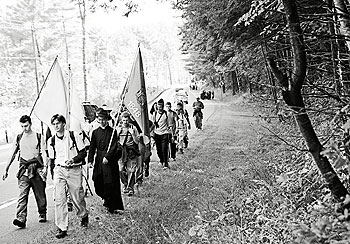Complete with great black and white photos, including the one below, the award-winning Adirondack Life magazine wrote up our spiritual journey through their part of the world. An excerpt follows, with the essay by Lisa Bramen and photographs by Jason Hupe also linked below.

MOTORISTS slow at the sight of a long line of pedestrians—more than 270 of them—stretching single-file along the dirt shoulder of Route 9N south of Lake George. A few of the walkers, teenage girls, wave cheerfully at the passing cars, and the gesture is occasionally reciprocated, if with quizzical looks.
A long walk in the Adirondacks is a common enough endeavor. Even a 65-mile trek, like the one this group is undertaking, is barely notable—dozens of people hike the 133-mile Northville-Placid Trail each year—but most distance-walkers follow wooded trails, not two-lane highways.
Other details about this procession are bound to stoke the curiosity of passersby: Almost all of the females wear long skirts—hardly the usual hiking attire—and many cover their hair with lacy scarves. At the head of each group of 15 or so is a leader carrying a satin banner or flag proclaiming the name of the “brigade” it represents—Sainte Jeanne d’Arc, Our Lady of Fatima Scouts. Others hold up tall wooden crucifixes. If these hints don’t clue the drivers in to the fact that they are witnessing a religious pilgrimage, the smattering of nuns in habits and priests in black robes might clinch it.
The Pilgrimage for Restoration, organized by Pennsylvania-based National Coalition of Clergy and Laity, has brought hundreds of the faithful to the Adirondack Park each September since 1996 for four days of walking, prayer and fellowship. The route—from the village of Lake George to the Shrine of Our Lady of Martyrs, at Auriesville, 40 miles west of Albany on the Mohawk River—commemorates the life and martyrdom of the saint Isaac Jogues, a 17th-century French Jesuit missionary who was captured, tortured and eventually murdered by the Mohawks, one of the five original nations of the Iroquois Confederacy. Jogues is believed to have been the first European to see the heart of the Adirondacks. Read more …


